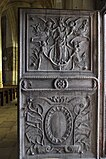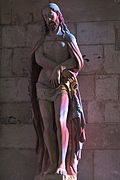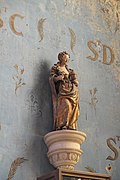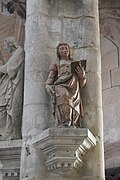Notre-Dame (Vétheuil)
The Catholic parish church of Notre-Dame de la Nativité de la Sainte Vierge in Vétheuil , a municipality in the Val-d'Oise department in the French region of Île-de-France , was opened in the 12./13. started in the Gothic style and completed in the 16th century in the Renaissance style. Wall and ceiling paintings and numerous sculptures from the Renaissance have been preserved in the church. The church, consecrated to the Virgin Mary , was added to the list of architectural monuments in France in 1840 as Monument historique .
Claude Monet , who lived in Vétheuil for almost four years, used the Notre-Dame church as the motif for several of his paintings.
history
The current church was built on the site of a previous building from the 10th century. This first church, of which nothing has survived, is attested by a deed of donation in which it is subordinated to the Fécamp Abbey . At the end of the 12th or beginning of the 13th century, the construction of the choir and the crossing tower began . The nave , the transept and the two portals were not completed until the 16th century, during the transition from Flamboyant Gothic to Renaissance . The size of the church, its elevated position and the imposing staircase suggest that it was the destination of a pilgrimage .
architecture
Choir head and tower
The head of the choir is structured by massive buttresses with several steps . In between there are tall, pointed arched windows framed by slender columns with round windows above. The crossing tower, which, like the head of the choir, originates from the first phase of construction, is pierced on all four sides by large, coupled sound arcades surrounded by archivolts .
West facade
Three balustrades mark the horizontal structure of the west facade, which is closed at the top by a round gable and in the middle of which the west portal opens. It is framed by two narrow stair towers, which are crowned by octagonal tops with a dome and a lantern . The two door openings are separated by a pillar of the Trumea with a group of figures presumably supposed to represent Mary with Baby Jesus and John the Baptist . In the tympanum above , niches have been cut that were originally occupied by sculptures, some of which are now kept in the church.
South portal
A large staircase dating back to the 16th century leads to the south portal, which is integrated into a vestibule. It is attributed to the Grappin family of architects from Gisors and was built between 1540 and 1547. The sculpture of the Madonna and Child on the Trumea pillar dates - like the wood-carved door wings - from the 16th century.
inner space
The one-bay choir closes with a semicircular apse and is covered by a six-part ribbed vault. The capitals and consoles of the columns are still in the Romanesque tradition. A door with flamboyant decor leads to the sacristy .
The nave has three aisles and is divided into four bays. Chapels are built on the side aisles. The main nave and aisles are covered with four-part ribbed vaults. The eastern nave yokes are Gothic, the western yoke shows the style of the early Renaissance.
Wall and ceiling paintings
Wall paintings from the 16th and 17th centuries are preserved on the pillars of the crossing and in the Chapelle de la Confrérie de la Charité (Chapel of the Brotherhood of Christian Love). The four evangelists with their symbols are depicted on the ceiling paintings of the brotherhood chapel . The wall painting on the west side of the chapel depicts the Last Judgment in the upper area and a funeral procession of the brotherhood below . During the great plague epidemics, the members of the brotherhood looked after the dying and their burial.
Furnishing
- The fragments of a colored and partially gilded carved altar with scenes of the Passion are kept in a side chapel . The altar is dated to the early 16th century and originally consisted of seven scenes. It was stolen in the 1960s and 1970s. Four scenes, the flagellation , the Judas kiss , the descent from the cross and the burial of Christ , were found and brought back.
- The large statues of saints on the pillars of the nave date mostly from the 16th century. They stand on consoles and are crowned by canopies. In the side chapels there are other figures of bishops, martyrs and saints from the 14th, 15th and 16th centuries, which were originally placed elsewhere.
- The sculpture Ecce homo is dated to the 17th century and still has remains of the original color .
- The Chapelle de la Confrérie de la Charité has a wood-carved barrier from the mid-16th century.
- The pulpit is a 17th century work. The pulpit is decorated with the reliefs of the four evangelists.
- The baptismal font dates from the 13th century and is carved with large rosettes .
literature
- Jean-Marie Pérouse de Montclos (ed.): Le Guide du Patrimoine. Île-de-France . Hachette, 2nd edition, Paris 1994, ISBN 2-01-016811-9 , pp. 715-717.
- Georges Poisson (ed.): Dictionnaire des Monuments d'Île-de-France . Éditions Hervas, Paris 2001, ISBN 2-84334-002-0 , p. 106.
- Le Patrimoine des Communes du Val-d'Oise . Flohic Éditions, Volume 2, Paris 1999, ISBN 2-84234-056-6 , pp. 600-601.
Web links
- Église Notre-Dame de Vétheuil accessed on January 29, 2014 (French)
- Église Notre-Dame in the Base Mérimée of the French Ministry of Culture (French)
Individual evidence
- ↑ Vantaux in the Base Palissy of the French Ministry of Culture (French)
- ↑ Vantaux du portail ouest in the Base Palissy of the French Ministry of Culture (French)
- ↑ Retable de la Passion in the Base Palissy of the French Ministry of Culture (French)
- ↑ Statuaire ( Memento of the original from March 22, 2016 in the Internet Archive ) Info: The archive link was inserted automatically and has not yet been checked. Please check the original and archive link according to the instructions and then remove this notice.
- ↑ Christ de Pitié in the Base Palissy of the French Ministry of Culture (French)
- ↑ Clôture de chapelle in the Base Palissy of the French Ministry of Culture (French)
- ↑ Chaire à prêcher in the Base Palissy of the French Ministry of Culture (French)
- ↑ Fonts baptismaux in the Base Palissy of the French Ministry of Culture (French)
Coordinates: 49 ° 3 '55.2 " N , 1 ° 42' 4.3" E


















